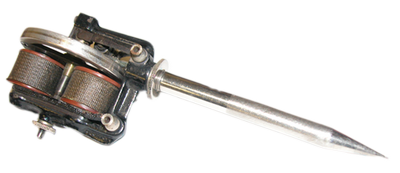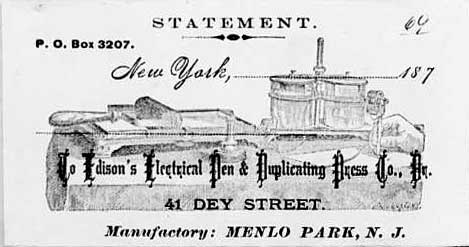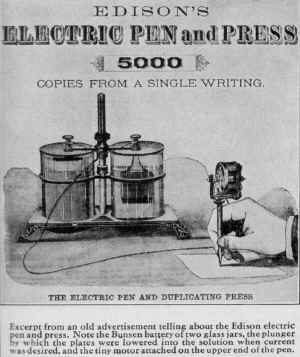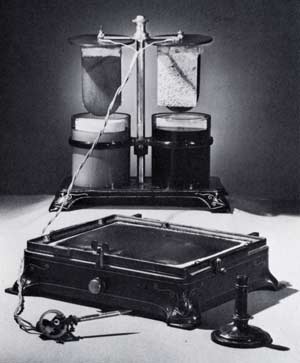
Rare Edison Electric Pen to be sold …… 1st invention in the world to use an electric motor.
That’s what it says in the morning paper.
Did you folks already know about this invention? WOW ... What a mind Edison had. There’s a better illustration in the hard copy but the Telegraph didn’t put it on line. Darn. So I went looking and found a few photos.

There’s an illustration here that shows two jars ... but the hard copy shows one jar that looks like a mason jar with a motor inside.
From The Telegraph
One of the few remaining Edison Electric Pens that was the first invention to have an electric motor is to be sold.
In 1875 Thomas Edison launched the pen to allow multiple copies to be made from the same handwritten manuscript - although the typewriter soon made it redundant.
The machine for sale that belonged to a collector is in full working order and comes with the associated Edison Mimeograph Duplicator.
The pen’s stylus would make 50 punctures per minute, perforating the paper with thousands of tiny holes.
This paper would then be placed into the duplicator and ink would be spread over it, creating as many copies as was desired.
Run off a wet-all battery in a glass jar, the pen was initially a hit, being sold all over the world.
At the time it was boasted that up to 15,000 copies could be made from the same stencil, with up to 15 possible in every minute.
Sales literature at the time from the US stated: “The apparatus is used by the United States, City and State Governments, Railroad, Steamboat and Express Companies, Lawyers, Architects, Engineers, Accountants, Printers and Business Firms in every department of trade.”
It added: “It is especially valuable for the cheap and rapid production of all matter requiring duplication...”
Originally the whole system could be purchased for 40 dollars, and there were different sized duplicators.
Uwe Breker, who runs an auction house in Cologne in Germany, expects to raise nearly £10,000 from the sale.
He said: “The Edison Electric Pen still works today, but you can use a modern 4.5 volt battery to power it.
“There are only thought to be about two dozen of these in the world and most are in museums so it is very rare for one to come on the open market.
“The electric pen was the very first item to be driven by an electric motor and is one of the earliest items of Edisonianan available to collectors.
“On August 8, 1876, Edison was granted U.S. patent number 180857 for his new invention.
“It sold well all over the world but the development of the typewriter reduced demand for it considerably.”
The is to be sold at Breker auctions on November 21.

Edison’s Electric Pen
1875: the beginning of office copying technology
by Bill Burns
Edison’s electric pen was the first electric motor driven appliance produced and sold in the United States, developed as an offshoot of Edison’s telegraphy research.Edison and Batchelor noticed that as the stylus of their printing telegraph punctured the paper, the chemical solution left a mark underneath. This led them to conceive of using a perforated sheet of paper as a stencil for making multiple copies, and to develop the electric pen as a perforating device. US patent 180,857 for “autographic printing” was issued to Edison on 8 August 1876.
The electric pen was sold as part of a complete duplicating outfit, which included the pen, a cast-iron holder with a wooden insert, a wet-cell battery on a cast-iron stand, and a cast-iron flatbed duplicating press with ink roller. All the cast-iron parts were black japanned, with gold striping or decoration.
The hand-held electric pen was powered by the wet-cell battery, which was wired to an electric motor mounted on top of a pen-like shaft. The motor drove a reciprocating needle which, according to the manual, could make 50 punctures per second, or 3,000 per minute. The user was instructed to place the stencil on firm blotting paper on a flat surface, then use the pen to write or draw naturally to form words and designs as a series of minute perforations in the stencil.
Later duplicating processes used a wax stencil, but the instruction manuals for Edison’s Electric(al) Pen and Duplicating Press variously call for a stencil of “common writing paper” (in Charles Batchelor’s manual), and “Crane’s Bank Folio” paper (in George Bliss’ later manual). Once the stencil was prepared it was placed in the flatbed duplicating press with a blank sheet of paper below. An inked roller was passed over the stencil, leaving an impression of the image on the paper. Edison boasted that over 5,000 copies could be made from one stencil.
The electric pen proved ultimately unsuccessful, other simpler methods (and eventually the typewriter) succeeding it for cutting stencils. But Edison’s duplicating technology was licensed to A.B. Dick, who sold it as “Edison’s Mimeograph” with considerable success. The company is still in business today as an office products and equipment manufacturer.
All photos come from electricpen.org

